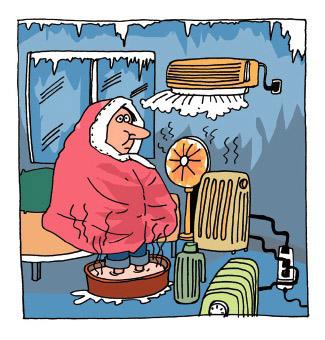There’s nothing like waking up in the middle of a Beijing winter to find that every form of heating in your house has broken. I got up one Wednesday morning to find that my underfloor heating circuit had broken, my portable heater’s plug wasn’t working, my shower pipes had frozen, causing water to cascade off the roof, and – just to add insult to injury – that my phone’s OS had stopped working and so I couldn’t even call anyone to come fix anything.
It took me a couple of days of work to get everything back in shape; a flurry of finding workmen’s numbers and fixing days to get things fixed. That meant a lot of extra clothing for me, as well as excursions to our local public showers. I’ve read a lot of stories about the traditional bonding culture of the public shower, and how it expresses something unique in Chinese culture. But it mostly seemed to be a lot of wrinkly old men talking about the weather. As I crouched under the shower, wondering why the lockers were covered in Finnish wrapping tape, I longed for the refinements of civilization again.
It wasn’t the first time I’d been through a Beijing freeze. I used to live in an old apartment block dependent entirely on government-run central heating, and the weeks before the system was officially turned on every year were among the coldest I’ve ever been at home. Even after the boiler cranked back into life each November, I’d often find my own pipes were still frozen, and have an extra-cold few days before I could get them restored. I wasn’t as badly off as my friend Nick, who spent a bitter winter in what he thought was a heating-less small room until I turned up and pointed out that his air conditioning unit was also a heater.
There’s no human need more primordial than heat. Even hunger pales beside it. Cold grips you by the guts – when you’re really cold it makes it impossible to think about anything else. I’ve been through the Mongolian and Siberian winters, and there the whole season revolves around heat. If you wrap up, you have about an hour’s worth of internal body heat to work off when you go outside, and then suddenly your reserves wear down, the frost grips you, and you scrabble to get to the nearest warmth. Whole towns have disappeared in Siberia after the old Soviet heating systems broke down, rendering once-prosperous neighborhoods unlivable.
Beijing’s a little warmer than Mongolia. But my great breakdown hit during xiaoxue, “little snow,” as the traditional Chinese calendar refers to the cold snaps that often strike in early December. Temperatures were well below freezing and, as I huddled in long johns, sweaters, and three pairs of socks, I reflected on how vital heating was to survival in China’s north.
Traditionally, Chinese families depended on the kang, a huge central stove bed, for heating in the winter. The kang was kept fueled throughout the cold season, preserving heat for the whole room through an elaborate flue system, somewhat like the old Roman hypocausts in Europe. Families slept, ate, and hosted guests on the kang, allowing everyone to survive throughout the bleak winter months. I’ve stayed at Mongolian guesthouses that still used such devices, and I can testify to their toasty warmth.
But that’s not the only precaution taken by Northerners against the cold. Many families used to bring their animals in for the winter, snuggling up against sheep or pigs in order to make the best use of their body heat. Others sewed themselves into their clothes for the winter, retaining only a small flap at the back for the most vital of bodily functions.
Beijingers aren’t quite as extreme today. But they are still very keen on wrapping up well. I come from the north of England, where we pride ourselves on wearing as little as possible in the snow. The average Northern lass on an evening out in freezing temperatures wears a miniskirt, tube top and fake tan. I sometimes like to stroll out in my hutong wearing a t-shirt in the dead of winter, just to prove a point.
But scanty clothing is a good way to draw the ire of local grandmothers. “Ai-yah, what are you wearing!” my neighbor Mrs Wang remarked when I came downstairs one day in less than the requisite number of layers. “Don’t you know it’s the winter?” One day, having left my coat at home and running down to the store to grab something, I was scolded by no less than four of my neighbors on a five-minute trip. Stopping to have all those conversations, of course, meant I really did catch a cold.
Yet the great irony of Chinese heating is that, for many people, the north is actually warmer than the south during the winter. That’s because the country’s central heating line runs along the Huai River and the Qinling Mountains – north of there, thanks to decisions made decades ago, you get heat, south you have to rely on your own resources. That’s ok if you’re all the way down in the tropics, but if you’re close to the border and it’s a bad winter, you better be prepared to splash out on electric heaters and giant duvets.
Of course, all that northern heat comes with a price; the choking air pollution that fills our cities every winter. But think in the long term. All those emissions are ultimately contributing to global warming. Raise the temperature a couple of notches, and Beijing will turn from a frozen hellscape into a balmy paradise-and one with a sea coast, just for a bonus.

 Old Version
Old Version